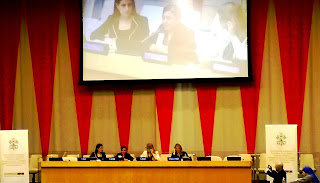Disturbing Evidence of Genocide and Heritage Destruction by ISIS Revealed at UN Congress
 |
| Panelists share evidence of ISIS atrocities with the international community from the chamber of the UN Economic and Social Council. |
A United Nations report published in 2014 expressly recognized the link between heritage destruction and atrocity crimes, and last week a UN congress meeting in New York brought this distressing feature into focus.
Titled Defending Religious Freedom and Other Human Rights: Stopping Mass Atrocities Against Christian and Other Believers, the UN congress revealed shocking first-hand evidence of genocide, crimes against humanity, and war crimes committed by ISIS against Christians and other religious minorities in Iraq and Syria.
The Permanent Observer Mission of the Holy See to the UN assembled the international event in the wake of U.S. Secretary of State John Kerry’s unexpected declaration last month that accused ISIS of committing genocide against Christians, Yazidis, and Shiite Muslims as that term is defined by the 1948 Convention on the Prevention and Punishment of the Crime of Genocide and its enabling statute in the U.S., the Genocide Convention Implementation Act.
Carl Anderson, CEO of the 1.9 million member Knights of Columbus (K of C), the largest lay Catholic charitable organization in the world, testified that Christians, Yazidis, and other religious minorities have been repeatedly subjected to rape, murder, property confiscation, slavery, and forced expulsion by ISIS.
It is estimated the number of Christians has dropped from 1.5 million to 200,000 in Iraq, and from 1.5 million to 500,000 in Syria, Anderson declared to the international congress with a notable sense of urgency. He warned the community of nations that indigenous Christians with ancient ties to the region “are at risk of disappearing entirely,” declaring that “[r]eligious minorities have an indisputable right to live in their homeland.”
 |
| Participants attending the UN Congress in NY. |
A missionary in Aleppo, Sr. Maria de Guadalupe, told about the persecution of Syrian Christians, but she added, in the face of danger, they have courageously exclaimed, “The experience of death has made us understand the sense of life.”
I must renew my repeated appeals regarding to the painful situation of the entire Middle East, North Africa and other African countries, where Christians, together with other cultural or ethnic groups, and even members of the majority religion who have no desire to be caught up in hatred and folly, have been forced to witness the destruction of their places of worship, their cultural and religious heritage, their houses and property, and have faced the alternative either of fleeing or of paying for their adhesion to good and to peace by their own lives, or by enslavement.
The congress took place at a time when parallel legal efforts to curb terrorist activities in Iraq and Syria are in motion. They include the unanimously adopted UN Security Council Resolution 2199, which aims to restrict ISIS and Al Nusra Front from raising money by means of cultural heritage trafficking, oil smuggling, and kidnapping. The recently passed Protect and Preserve International Cultural Property Act, likewise, is federal legislation that House and Senate leaders hope will curb smuggling of illegal Syrian artifacts into the U.S. That legislation awaits the signature of President Barack Obama before becoming law.
To help preserve lives and heritage in Iraq and Syria before they are wiped out, readers may contact In Defense of Christians, Roads of Success, the Knights of Columbus, or similar organizations that seek to help persecuted religious minorities in the region, which include Yazidis, Shia and Sunni Muslims, Turkmen, Shabaks, Sabean-Mandeans, Kaka’e, Kurds, and Jews, as well as Assyrian, Chaldean, Syriac, Armenian, Catholic, Coptic, Evangelical, Melkite, and Orthodox Christians.
Video of the UN Congress on Defending Religious Freedom and Other Human Rights appears below, courtesy of United Nations Webcast.
Text copyrighted 2016 by Cultural Heritage Lawyer, a blog commenting on matters of cultural property law, art law, cultural heritage policy, antiquities trafficking, and museum risk management. Blog url: culturalheritagelawyer.blogspot.com. Any unauthorized reproduction or retransmission of any blog post without the express written consent of CHL is prohibited. CHL is a service of Red Arch Cultural Heritage Law & Policy Research, Inc.

